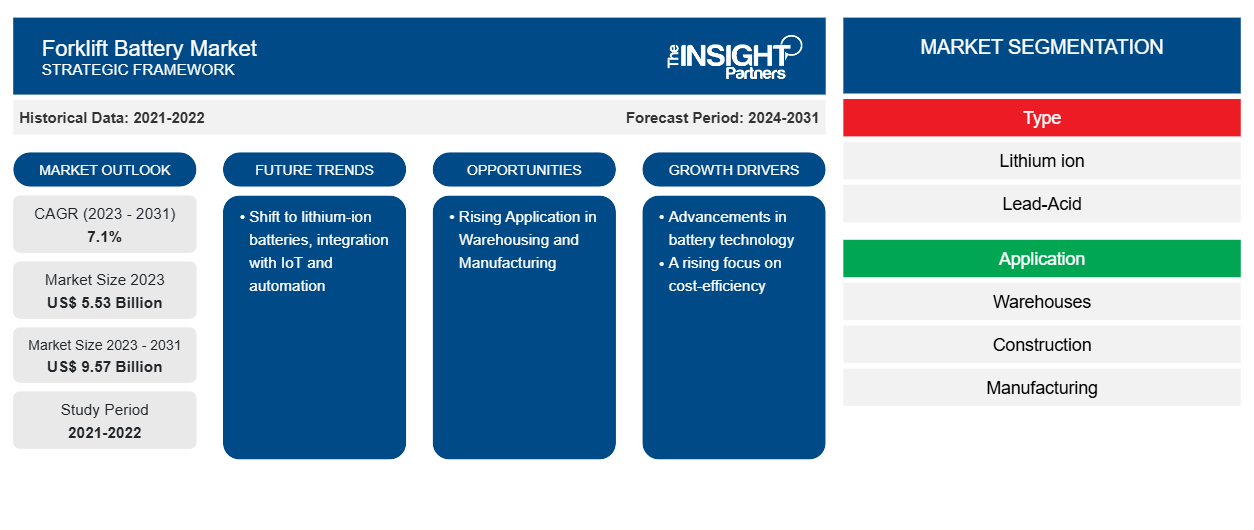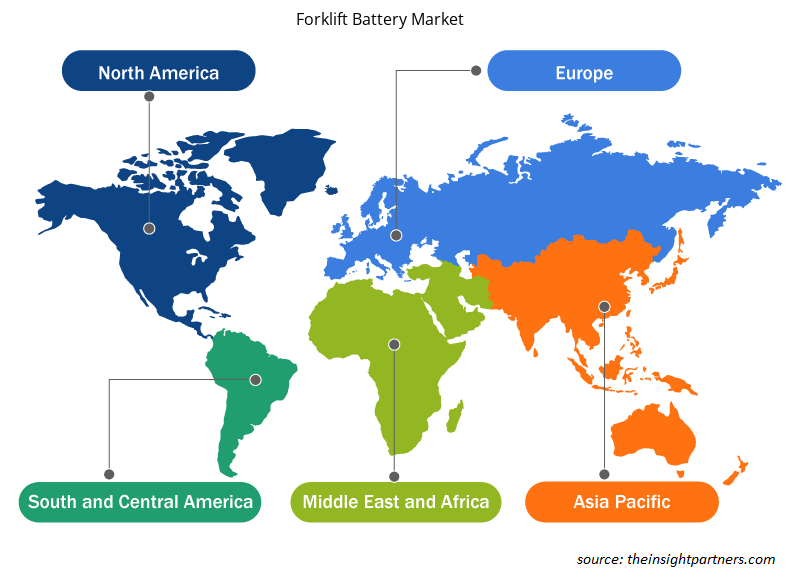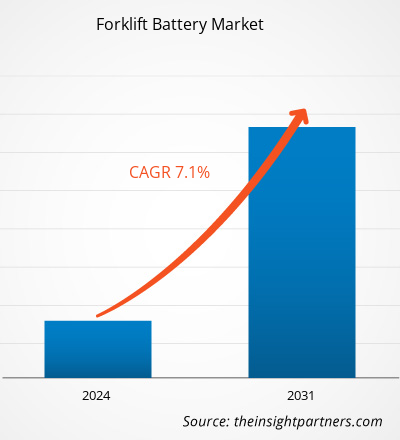قُدِّر حجم سوق بطاريات الرافعات الشوكية بـ 5.94 مليار دولار أمريكي في عام 2024، ومن المتوقع أن يصل إلى 9.23 مليار دولار أمريكي بحلول عام 2031؛ ومن المتوقع أن يسجل معدل نمو سنوي مركب بنسبة 6.6% بين عامي 2025 و2031. ومن المرجح أن يُسهم دمج خدمة البطاريات (BaaS) في الرافعات الشوكية في ظهور اتجاهات جديدة في السوق في السنوات القادمة.
تحليل سوق بطاريات الرافعات الشوكية
يشهد سوق بطاريات الرافعات الشوكية نموًا ملحوظًا، مدفوعًا بالتوسع السريع في قطاعي التخزين والتجارة الإلكترونية، وتزايد التصنيع، والتحول العالمي نحو الرافعات الشوكية الكهربائية لتحقيق الاستدامة والكفاءة من حيث التكلفة. تُغذي هذه التوجهات الطلب على حلول البطاريات المتطورة لدعم ساعات تشغيل أطول وخفض الانبعاثات. تشمل الفرص المتاحة في السوق تطوير تقنيات الشحن السريع والفعال، مما يقلل من فترات التوقف ويعزز الإنتاجية. بالإضافة إلى ذلك، تُحسّن الابتكارات في أنظمة إدارة البطاريات الذكية الأداء والسلامة وكفاءة الطاقة. تُقدم هذه التطورات آفاقًا واعدة للمصنعين وأصحاب المصلحة الذين يسعون إلى تلبية الاحتياجات المتطورة لصناعة مناولة المواد.
نظرة عامة على سوق بطاريات الرافعات الشوكية
يمكن لبطارية الرافعة الشوكية أن تُشكّل مصدر طاقة لتشغيل الرافعات الشوكية والشاحنات الصناعية الأخرى، موفرةً الطاقة اللازمة لعمليات مناولة المواد. تستخدم الرافعات الشوكية عادةً بطاريات الرصاص الحمضية أو بطاريات الليثيوم أيون (Li-ion)، وتُعد الأخيرة أكثر شيوعًا نظرًا لقدراتها على الشحن السريع، وعمرها الافتراضي الأطول، وتأثيرها البيئي المنخفض، من بين مزايا أخرى. وقد ازداد الطلب على بطاريات الرافعات الشوكية بشكل ملحوظ مع ازدياد شعبية الرافعات الشوكية الكهربائية، التي تُفضّل لاستدامتها، وانخفاض احتياجات صيانتها، وفعاليتها من حيث التكلفة مقارنةً بالرافعات الشوكية التقليدية التي تعمل بمحركات الاحتراق الداخلي (ICE). تشتهر الصناعات الأوروبية والأمريكية الشمالية بتركيزها على الحلول الصديقة للبيئة لتقليل بصمتها الكربونية، مما يزيد من الطلب على الرافعات الشوكية الكهربائية. تلعب بطاريات الرافعات الشوكية دورًا محوريًا في قطاعات الخدمات اللوجستية والتخزين والتصنيع، حيث تُشغّل مختلف الآلات الضرورية لمناولة المواد ونقلها. بالإضافة إلى تزايد استخدام الرافعات الشوكية الكهربائية، فإن ازدياد استخدام الأتمتة في المستودعات في مختلف القطاعات الصناعية يُعزز نمو السوق.
ستحصل على تخصيص لأي تقرير - مجانًا - بما في ذلك أجزاء من هذا التقرير، أو تحليل على مستوى الدولة، وحزمة بيانات Excel، بالإضافة إلى الاستفادة من العروض والخصومات الرائعة للشركات الناشئة والجامعات
سوق بطاريات الرافعات الشوكية: رؤى استراتيجية

-
احصل على أهم اتجاهات السوق الرئيسية لهذا التقرير.ستتضمن هذه العينة المجانية تحليل البيانات، بدءًا من اتجاهات السوق وحتى التقديرات والتوقعات.
محركات وفرص سوق بطاريات الرافعات الشوكية
توسيع المستودعات والتجارة الإلكترونية
يشهد قطاع التجارة الإلكترونية ازدهارًا ملحوظًا بفضل زيادة انتشار الإنترنت والهواتف الذكية، وتطور تفضيلات المستهلكين، والتقدم التكنولوجي. علاوة على ذلك، تشهد التجارة الإلكترونية عبر الحدود نموًا متزايدًا مع سعي المستهلكين للحصول على منتجات فريدة بأسعار تنافسية على الصعيد الدولي. ووفقًا لمكتب الإحصاء الأوروبي (يوروستات)، ارتفعت نسبة الشركات التي اعتمدت استراتيجية المبيعات الإلكترونية في الاتحاد الأوروبي من 17.21% عام 2013 إلى 23.83% عام 2023. وتفتتح العديد من شركات التجارة الإلكترونية مستودعات لها في جميع أنحاء العالم. على سبيل المثال، أطلقت أمازون، عملاق التجارة الإلكترونية، أول مركز توزيع لها في هولندا في أغسطس 2023. وبفضل هذا المرفق الجديد، ستتمكن منصة التسوق الإلكتروني من تلبية الطلبات الهولندية دون أي تأخير. وقد أدى النمو السريع للتجارة الإلكترونية إلى زيادة الطلب على حلول مناولة المواد الفعالة والنظيفة في المستودعات. وتستجيب شركات مثل أمازون ودي إتش إل لهذا الطلب بنشر أساطيل من الرافعات الشوكية التي تعمل بالبطاريات لتعزيز الكفاءة التشغيلية وتقليل الأثر البيئي. على سبيل المثال، في مارس 2022، طرحت شركة DHL Supply Chain أحدث مجموعة من الرافعات الشوكية ذاتية التشغيل في أوروبا القارية؛ وكانت هذه الرافعات أحدث إضافة إلى مستودعها متعدد المستخدمين في بورنيم، بلجيكا. وكان تركيب هذه الرافعات الروبوتية الداخلية ذاتية التشغيل لنقل المنصات جزءًا من استراتيجية الشركة للتحول الرقمي المتسارع. وبالتالي، يُعيد ازدياد التسوق عبر الإنترنت تشكيل المشهد اللوجستي، مما يدفع الشركات إلى الاستثمار في المستودعات الآلية والرافعات الشوكية التي تعمل بالبطاريات. ويؤثر هذا التحول بشكل مباشر على الطلب على بطاريات الرافعات الشوكية الفعالة والمتينة، وخاصةً بطاريات أيونات الليثيوم وحمض الرصاص، لدعم العمليات على مدار الساعة.
التطورات في ميزات الشحن السريع والفرص
مع تزايد استخدام الرافعات الشوكية الكهربائية حول العالم، يتزايد التركيز على حلول الشحن المتقدمة، مثل الشحن السريع والشحن بالفرص. تُثبت هذه الطرق فعاليتها للشركات التي تعمل بنظام ورديات متعددة، نظرًا لقدرتها على تقليل وقت التوقف عن العمل وتحسين الكفاءة. عادةً، تتبع بطاريات الرافعات الشوكية دورة شحن تقليدية، تتضمن 8 ساعات تشغيل، و8 ساعات شحن، و8 ساعات تبريد. تُحد هذه الدورة من توفر البطارية، وغالبًا ما تُجبر الشركات على شراء بطاريات إضافية للحفاظ على استمرارية العمليات عبر ورديات متعددة، مما يزيد من التكلفة واحتياجات التخزين. تُعالج طرق الشحن السريع والشحن بالفرص هذا التحدي من خلال السماح لمشغلي الرافعات الشوكية بالشحن خلال فترات الراحة القصيرة، أو أوقات الوجبات، أو ساعات الليل. يُساعد هذا في الحفاظ على شحن البطارية في نطاق 40-80%، مما يُبقي الرافعات الشوكية جاهزة للاستخدام طوال اليوم. للحفاظ على صحة البطارية وضمان أعلى أداء، من المهم إجراء شحن مُعادل أسبوعي، مما يُوصل البطارية إلى نسبة شحن 100% كاملة، ويساعد على منع تراكم الكبريتات.
مع تزايد سعي الشركات لتحسين زمن التشغيل وخفض تكاليف التشغيل، من المتوقع أن يزداد الطلب على البطاريات وأنظمة الشحن المتوافقة مع هذه الطرق. وبالتالي، يُمثل التحول نحو الشحن السريع والفعال فرصة نمو كبيرة لسوق بطاريات الرافعات الشوكية.
تقرير تحليل تجزئة سوق بطاريات الرافعات الشوكية
إن القطاعات الرئيسية التي ساهمت في اشتقاق تحليل سوق بطاريات الرافعة الشوكية هي النوع والسعة والتطبيق.
- يُقسّم سوق بطاريات الرافعات الشوكية، حسب نوعها، إلى بطاريات ليثيوم أيون، وبطاريات الرصاص الحمضية، وغيرها. وقد هيمنت بطاريات الرصاص الحمضية على السوق في عام ٢٠٢٤.
- بناءً على السعة، يُقسّم سوق بطاريات الرافعات الشوكية إلى فئات بطاريات من 0 إلى 600 أمبير ساعة، وبطاريات من 600 إلى 1200 أمبير ساعة، وبطاريات أكثر من 1200 أمبير ساعة. وقد استحوذت فئة بطاريات من 0 إلى 600 أمبير ساعة على الحصة الأكبر من السوق في عام 2024.
- بناءً على التطبيق، يُقسّم سوق بطاريات الرافعات الشوكية إلى قطاعات المستودعات والخدمات اللوجستية، والبناء، والتصنيع، ومتاجر التجزئة والجملة، والسيارات، وغيرها. وقد هيمن قطاع التصنيع على السوق في عام ٢٠٢٤.
تحليل حصة سوق بطاريات الرافعات الشوكية حسب المنطقة الجغرافية
- يُقسّم سوق بطاريات الرافعات الشوكية إلى خمس مناطق رئيسية: أمريكا الشمالية، وأوروبا، وآسيا والمحيط الهادئ، والشرق الأوسط وأفريقيا، وأمريكا الجنوبية والوسطى. وقد هيمنت منطقة آسيا والمحيط الهادئ على السوق في عام 2024، تلتها أوروبا وأمريكا الشمالية.
- يُعزى نمو سوق بطاريات الرافعات الشوكية في أمريكا الشمالية إلى توسع قطاعات الخدمات اللوجستية والنقل والتجارة الإلكترونية. وقد ازداد التسوق عبر الإنترنت في الولايات المتحدة في السنوات الأخيرة. وأعلن مكتب الإحصاء التابع لوزارة التجارة أن تقديرات مبيعات التجزئة الإلكترونية في الولايات المتحدة للربع الرابع من عام 2024، بعد تعديلها وفقًا للتغيرات الموسمية دون مراعاة تغيرات الأسعار، بلغت 308.9 مليار دولار أمريكي، بزيادة قدرها 2.7% (±0.9) عن الربع الثالث من عام 2024. وقد أدركت العديد من شركات الخدمات اللوجستية العملاقة في السوق، مثل UPS وFedEx وUSPS وXPO Logistics وAmazon، الطلب المتزايد على الرافعات الشوكية في مستودعاتها. وقد استثمرت هذه الشركات بشكل كبير في إنشاء المستودعات وأتمتة عملياتها اللوجستية. على سبيل المثال، في نوفمبر 2023، افتتحت شركة United Parcel Service أكبر مستودع لها في لويزفيل بولاية كنتاكي، بمساحة تبلغ حوالي 20 فدانًا. صُمم هذا المستودع لتخزين ومناولة الطرود، باستثمار كبير قدره 79 مليون دولار أمريكي لتركيب أكثر من 3000 روبوت آلي ومركبة صناعية. ستتولى هذه الروبوتات والمركبات الصناعية مهام متعددة في المستودعات، مثل رفع ونقل البضائع من مكان إلى آخر، مما يُقلل من الحاجة إلى العمل اليدوي.
- يتأثر سوق بطاريات الرافعات الشوكية في أوروبا بنمو قطاع الأغذية والمشروبات، والطلب المتزايد على الخدمات اللوجستية والنقل، ونمو قطاع التسوق والتجارة. يتطلب قطاع الخدمات اللوجستية مركبات صناعية، مثل الرافعات الشوكية، لرفع ونقل البضائع من مكان إلى آخر. ووفقًا للإحصاءات التي نشرتها المفوضية الأوروبية في يوليو 2024، فقد استثمرت 7.97 مليار دولار أمريكي في 134 مشروعًا للبنية التحتية للنقل لضمان بنية تحتية مستدامة وآمنة وذكية للنقل. وقد خصص الاتحاد الأوروبي هذا الاستثمار الاستراتيجي لأتمتة البنية التحتية للنقل والخدمات اللوجستية. وقد أدى نمو قطاع الخدمات اللوجستية إلى زيادة الطلب على الرافعات الشوكية الكهربائية لمناولة المواد في المستودعات، مما ساهم بدوره في نمو سوق بطاريات الرافعات الشوكية.
رؤى إقليمية حول سوق بطاريات الرافعات الشوكية
قام محللو شركة إنسايت بارتنرز بشرح شامل للاتجاهات والعوامل الإقليمية المؤثرة في سوق بطاريات الرافعات الشوكية خلال فترة التوقعات. كما يناقش هذا القسم قطاعات سوق بطاريات الرافعات الشوكية ونطاقها الجغرافي في أمريكا الشمالية، وأوروبا، وآسيا والمحيط الهادئ، والشرق الأوسط وأفريقيا، وأمريكا الجنوبية والوسطى.

- احصل على البيانات الإقليمية المحددة لسوق بطاريات الرافعات الشوكية
نطاق تقرير سوق بطاريات الرافعات الشوكية
| سمة التقرير | تفاصيل |
|---|---|
| حجم السوق في عام 2024 | 5.94 مليار دولار أمريكي |
| حجم السوق بحلول عام 2031 | 9.23 مليار دولار أمريكي |
| معدل النمو السنوي المركب العالمي (2025 - 2031) | 6.6% |
| البيانات التاريخية | 2021-2023 |
| فترة التنبؤ | 2025-2031 |
| القطاعات المغطاة |
حسب النوع
|
| المناطق والدول المغطاة |
أمريكا الشمالية
|
| قادة السوق وملفات تعريف الشركات الرئيسية |
|
كثافة اللاعبين في سوق بطاريات الرافعات الشوكية: فهم تأثيرها على ديناميكيات الأعمال
يشهد سوق بطاريات الرافعات الشوكية نموًا سريعًا، مدفوعًا بتزايد طلب المستخدمين النهائيين نتيجةً لعوامل مثل تطور تفضيلات المستهلكين، والتقدم التكنولوجي، وزيادة الوعي بمزايا المنتج. ومع تزايد الطلب، تعمل الشركات على توسيع عروضها، والابتكار لتلبية احتياجات المستهلكين، والاستفادة من الاتجاهات الناشئة، مما يُعزز نمو السوق.
تشير كثافة اللاعبين في السوق إلى توزيع الشركات العاملة في سوق أو قطاع معين. وتشير إلى عدد المنافسين (اللاعبين في السوق) الموجودين في سوق معين نسبةً إلى حجمه أو قيمته السوقية الإجمالية.
الشركات الرئيسية العاملة في سوق بطاريات الرافعات الشوكية هي:
- شركة HOPPECKE Carl Zoellner & Sohn GmbH للمجمعات الصناعية
- شركة كراون للمعدات
- شركة إكسايد للصناعات المحدودة
- إنيرسيس
- شركة إيست بن للتصنيع
- شركة أمبريكس المعاصرة للتكنولوجيا المحدودة
إخلاء المسؤولية : الشركات المذكورة أعلاه ليست مرتبة بأي ترتيب معين.

- احصل على نظرة عامة على أهم اللاعبين الرئيسيين في سوق بطاريات الرافعات الشوكية
أخبار سوق بطاريات الرافعات الشوكية والتطورات الأخيرة
يُقيّم سوق بطاريات الرافعات الشوكية بجمع بيانات نوعية وكمية بعد البحث الأولي والثانوي، والتي تشمل منشورات الشركات المهمة، وبيانات الجمعيات، وقواعد البيانات. فيما يلي بعض التطورات في سوق بطاريات الرافعات الشوكية:
- وقعت شركة BSL New Energy Technology Co., Ltd.، وهي الشركة الصينية الرائدة في تصنيع بطاريات الليثيوم التي توفر بطاريات LiFePO4 عالية الجودة لتطبيقات الطاقة الحركية وتخزين الطاقة، اتفاقية تعاون استراتيجي مع شركة REPT BATTERO Energy Co., Ltd. لتقديم حلول بطاريات الليثيوم للرافعات الشوكية.
(المصدر: شركة BSL لتكنولوجيا الطاقة الجديدة المحدودة، بيان صحفي، يوليو 2024)
- تُطلق شركة East Penn Manufacturing Co. سلسلة منتجات Deka Ready Power الجديدة في معرض ProMat 2025 في شيكاغو، إلينوي. تُلبي سلسلة بطاريات Deka Ready Power الحاجة المتزايدة للمنتجات التي لا تحتاج إلى صيانة لتطبيقات Motive Power، وذلك من خلال توفير تقنيتي الليثيوم والجيل، مما يُوفر أفضل قيمة في فئتها وأقل تكلفة إجمالية للملكية.
(المصدر: شركة إيست بن للتصنيع، بيان صحفي، مارس 2025)
تغطية تقرير سوق بطاريات الرافعات الشوكية والنتائج المتوقعة
يوفر تقرير "حجم سوق بطاريات الرافعات الشوكية وتوقعاته (2021-2031)" تحليلاً مفصلاً للسوق يغطي المجالات المذكورة أدناه:
- حجم سوق بطاريات الرافعة الشوكية وتوقعاتها على المستويات العالمية والإقليمية والوطنية لجميع قطاعات السوق الرئيسية التي يغطيها النطاق
- اتجاهات سوق بطاريات الرافعات الشوكية، بالإضافة إلى ديناميكيات السوق مثل العوامل المحركة، والقيود، والفرص الرئيسية
- تحليل مفصل لـ PEST و SWOT
- تحليل سوق بطاريات الرافعات الشوكية يغطي اتجاهات السوق الرئيسية والإطار العالمي والإقليمي والجهات الفاعلة الرئيسية واللوائح والتطورات الأخيرة في السوق
- تحليل المشهد الصناعي والمنافسة الذي يغطي تركيز السوق، وتحليل خريطة الحرارة، واللاعبين البارزين، والتطورات الأخيرة في سوق بطاريات الرافعات الشوكية
- ملفات تعريف الشركة التفصيلية
- التحليل التاريخي (سنتان)، سنة الأساس، التوقعات (7 سنوات) مع معدل النمو السنوي المركب
- تحليل PEST و SWOT
- حجم السوق والقيمة / الحجم - عالمي، إقليمي، بلد
- الصناعة والمنافسة
- مجموعة بيانات إكسل
التقارير الحديثة
تقارير ذات صلة
شهادات العملاء
سبب الشراء
- اتخاذ قرارات مدروسة
- فهم ديناميكيات السوق
- تحليل المنافسة
- رؤى العملاء
- توقعات السوق
- تخفيف المخاطر
- التخطيط الاستراتيجي
- مبررات الاستثمار
- تحديد الأسواق الناشئة
- تحسين استراتيجيات التسويق
- تعزيز الكفاءة التشغيلية
- مواكبة التوجهات التنظيمية






















 احصل على عينة مجانية ل - سوق بطاريات الرافعات الشوكية
احصل على عينة مجانية ل - سوق بطاريات الرافعات الشوكية